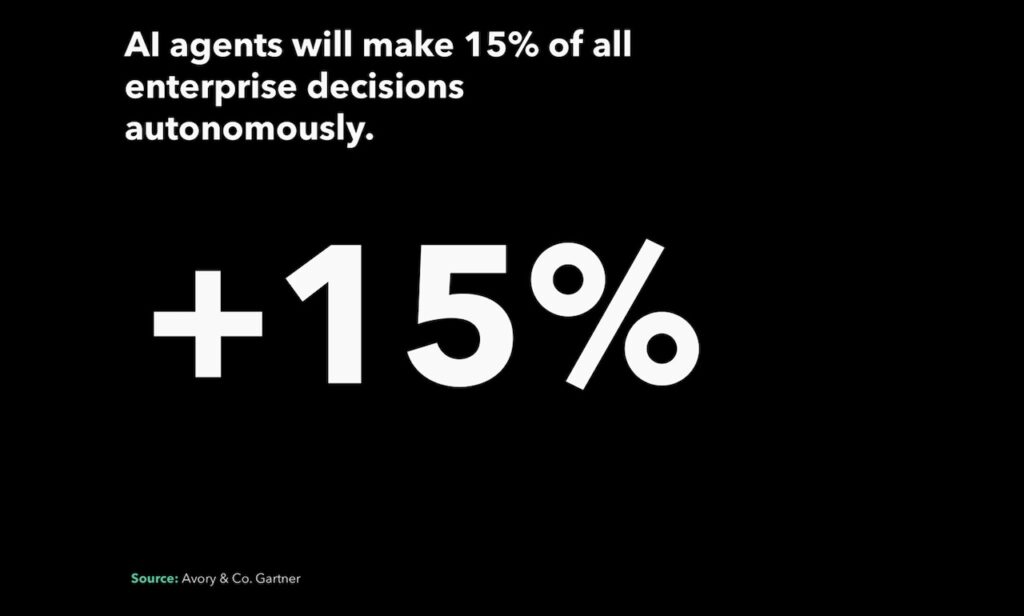Al isn’t just evolving-it’s shifting into an entirely new phase. The next frontier? Agentic Al, where software agents don’t just analyze data but actively make decisions and execute tasks.
The key word here is execute tasks. So far we have all been passively using Al to gather information or process data. This shift will impact automation, workforce allocation, regulation, and data management across industries.
For investors, the implications are clear: We’re looking at an inflection point that will drive enterprise spending, tech consolidation, and new market opportunities. Below, we break down the top trends to
watch.
Here’s the data within 3 key trends:
- 1.15% = autonomous decisions.
- 30% of hours from humans to agents.
- 500 ai bills introduced.
Data #1 – AI Moves from Thought to Action: The Rise of Agentic AI

Al agents will make 15% of all enterprise decisions autonomously.
AI is no longer just a tool for insights—it’s becoming an autonomous actor. Agentic AI allows software to plan, make decisions, and take action without predefined business rules. Gartner predicts that by 2028, AI agents will make 15% of all enterprise decisions autonomously ai-and-automation-trend….
- Enterprises will shift automation spend from process-based RPA to decision-making AI agents.
- Early movers are already seeing speed, efficiency, and personalization gains—this is real adoption, not just hype.
- Spending on agentic AI is projected to hit $4B by 2028, growing at a 68% CAGRai-and-automation-trend….
Companies developing agentic AI infrastructure (think orchestration, governance, and security layers) are positioned for growth.
Data #2 – The AI Workforce Shift: Who Keeps Their Job?
30% of all work hours will shift from humans to Al by 2030.
AI won’t just complement jobs, we think it can redefine them. Mostly for the better, as history has proven time and time again. A McKinsey report suggests 30% of all work hours will shift from humans to AI by 2030.The exact number matters less than the direction in our opinion. Here’s some things to think about.
- HR, IT, and operations leaders will need to rescope roles, retrain employees, and integrate AI tools into workflows.
- The fastest disruptions? Customer service, data analysis, and software development—industries where AI already drives productivity gains.
- Expect higher demand for STEM, legal, and healthcare roles but a declining need for repetitive office jobs.
We tend to like platforms that enable human-AI collaboration, like intelligent workflow tools, AI copilots, and upskilling platforms, are worth watching.
Data #3 – The Regulatory Crackdown on AI Is Here
500 Al-related bills introduced in 2024… Al companies will need strong compliance frameworks,
making governance solutions a critical growth area.
Regulators are moving fast. The EU’s AI Act, effective in August 2024, bans certain AI applications and forces transparency on training data. Meanwhile, the U.S. has seen nearly 500 AI-related bills introduced in 2024, up from just 130 in 2023.
- AI companies will need strong compliance frameworks, making governance solutions a critical growth area.
- Copyright lawsuits (e.g., Getty Images vs. Stability AI) signal rising risks in AI-generated content.
- Enterprises hesitant to adopt AI due to legal uncertainty may slow investment in unregulated markets.
Compliance-driven AI solutions (i.e., AI security, data lineage, and explainability tools) will see significant demand in our view.
Twitter: @_SeanDavid
The author and/or his firm have positions in the mentioned companies and underlying securities at the time of publication. Any opinions expressed herein are solely those of the author, and do not in any way represent the views or opinions of any other person or entity.








